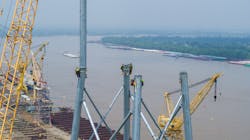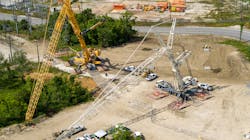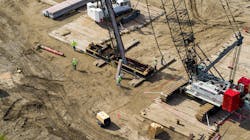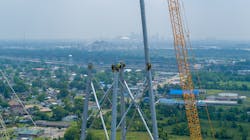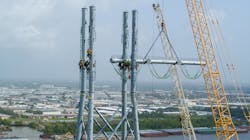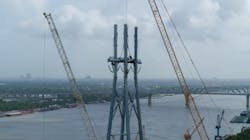One-Year Rebuild of a Mississippi River Crossing
On Aug. 29, 2021, 16 years to the day Hurricane Katrina forever changed the landscape of Greater New Orleans, Hurricane Ida followed in its devastating footsteps and, once again, challenged the resolve of the communities that call this area home. As part of the destruction wrought by the Category 4 storm that was Ida, Entergy Corp.’s Avondale-to-Harahan 230-kV river-crossing circuit was irreparably damaged. After the storm passed and damages were assessed, the utility discovered one of the existing river-crossing towers on the ground and the conductor in the Mississippi River, attached to the other still-standing tower.
Once initial restoration efforts were made to clear the Mississippi River of the conductor and clean up the destroyed tower, Entergy’s focus shifted to answering the following two questions: What solution should be implemented for the rebuild and could it be completed prior to the peak of the 2022 hurricane season?
The Prudent Path
When faced with the complete rebuild of a critical piece of infrastructure after a natural disaster, the foremost goal should be focused on what can be built safely into the new solution to preclude the infrastructure from ever failing again in a similar scenario. For a high-voltage river crossing spanning nearly 4000 ft (1219 m) across the Mississippi River, Entergy’s two primary options were either an overhead or an underground solution. These two options were analyzed in parallel to ascertain the most prudent path forward.
Preliminary feasibility studies were performed on the underground solution, but it was evident early on it would present numerous challenges, particularly with the targeted completion time frame of August 2022. Not only would it be difficult to find a suitable location in which to perform the horizontal directional bore needed for placing an underground transmission line sufficiently deep enough below the Mississippi River, but using a new underground crossing — in lieu of a replacement overhead solution — within the close vicinity of the U.S. Army Corps of Engineers (USACE) levee system also would complicate the permitting process significantly, all but guaranteeing a delay in the desired completion date.
Wind Loading Criteria
The analysis of an overhead solution proved to be much more realizable; it was not a matter of feasibility but rather what target wind loading criteria should be used. Wind loading criteria used for new transmission line construction in this geographic area is typically 150 mph (241 kmph). However, given the uptick in recent years in the frequency and severity of these weather events along the Gulf Coast, the project team was challenged with this question: Was a 175-mph (282 kmph) wind loading specification possible for this overhead crossing?
When this question was asked, Entergy transmission engineers were already in the preliminary design stage of the 150-mph wind loading criteria with the would-be producer of the river-crossing towers, Valmont. However, the Entergy and Valmont teams immediately began evaluating the 175-mph possibility.
When it was confirmed the towers could be built to withstand this unprecedented wind loading, the foundation engineering firm, Waldemar S. Nelson, ran its own calculations and developed a driven pile foundation plan for the towers that would accommodate the uprated design criteria. The final check was a constructability review, which validated that the change in wind ratings would not substantially alter the crews and equipment necessary to install both the foundations and the towers. By the end of October 2021, two workable options had been validated, and in early November, Entergy leadership elected to proceed with the 175-mph overhead solution.
Strong Foundations
With the design criteria finalized, both foundation and overhead detailed engineering were underway. The foundation design consisted of four pile caps, one for each tower leg, containing 30 concrete piles — 65-ft (20-m) long, driven at a battered angle and tied together by a concrete strap beam. The concrete piles were ordered in late 2021 and began arriving to the site in January 2022. Prior to driving piles, however, demolition was needed on both sides of the river. The tower that had failed during Ida was on the Avondale side of the river, and the existing foundations needed to be removed prior to pile driving; on the Harahan side of the river, the entirety of the existing tower remained.
The construction sequence developed was aimed to optimize the available resources while also not overcrowding the space-constrained sites. While the foundations were demolished by the site preparation contractor, Williamson Construction & Equipment Inc., at Avondale, arrangements were made with the crane vendor, TNT Crane & Rigging, and the steel erection contractor, A&J Steel Reinforcing Services Inc., to mobilize an 800-ton crane to begin the tower demolition at the Harahan site.
Once the foundations were removed at the Avondale site, pile driving began in early February while the Harahan tower was being removed. The foundation contractor, Boh Bros. Construction Co. LLC, used a custom-fabricated template to ascertain the correct battered angle for the piles and completed the Avondale pile installation in early March. When the pile driving crew demobilized to the now tower-less Harahan site to begin pile installation there, the Boh Bros. civil crew mobilized to the Avondale site to begin pile cap installation.
The concrete pile caps were 24.33 ft by 20.33 ft by 8.5 ft (7.4 m by 6.2 m by 2.6 m) and tied into the exposed rebar tension hooks of the concrete piles. Because of the poor soil conditions pervasive to this area of south Louisiana, large excavations were required for proper sloping and benching. At times, these also were reinforced with additional shoring. When the Avondale pile caps were completed in late April 2022, the civil crew mobilized to the Harahan site to begin pile cap installation, which was completed in early June 2022.
During this same period, the back-span dead-end structures on either side of the new towers were being installed by Legend Foundation Services. With the river crossing being rebuilt as a double circuit, each dead-end structure consisted of six steel monopoles set on top of concrete drilled-pier foundations. These dead-end structures also were rated to withstand 175 mph, ensuring the entirety of the rebuilt crossing had the same storm hardening criteria.
In addition to trying to complete the river crossing prior to the peak of hurricane season in late August, the project team also constantly had to monitor the Mississippi River level. Generally, when the Mississippi River hits more than 11 ft (3.4 m) on the USACE Carrollton Gauge, all subsurface-disturbing activities within 1500 ft (457 m) of the river must cease. This is particularly true from late winter to late spring, when the river typically reaches its zenith in late April; this time frame coincided exactly with when the subsurface work was occurring on the project.
The project was able to obtain a waiver from the USACE to increase the allowable river-level threshold slightly, which allowed the project to continue when the river did briefly exceed 11 ft during foundation construction. Fortunately, the river never exceeded the allowable limit and no delays occurred because of this risk.
Tower Design
While foundation construction was progressing, the tower design was completed and fabrication commenced. The final tower design specified two identical tubular-steel PyraMAX towers 475 ft (145 m) in total height. As part of the fabrication process, Valmont performed a fit test of critical tower members at its manufacturing facilities to ensure perfect alignment and mitigate delays during construction. The towers were slated to be delivered in mid-April 2022 to enable steel erection to begin as soon as the pile caps were completed at the Avondale site.
As steel deliveries began and the pieces were organized in the laydown yard, both an 800-ton and 900-ton crane were mobilized and set up. Because of the height of the towers and reach needed to install the top crossarms, a 900-ton crane was necessary, which also served as the primary steel erection crane; the 800-ton crane was used to transport personnel to minimize worker fatigue and assist with picks, when necessary.
Wire Pull Plan
Throughout the month of May 2022, tower erection took place at the Avondale site while the pile caps were being installed at the Harahan site, with both activities ending in early June 2022. At this point, all foundation work was complete and the only remaining task prior to the wire pull across the river was the erection of the Harahan tower. TNT Crane and A&J Steel both mobilized to the Harahan site to work on tower erection through June, while the transmission line contractor, Irby Construction Co., and members of the Entergy team developed the wire pull plan, which was scheduled to begin shortly after the Fourth of July.
To mitigate any failures during the 5650-ft (1722-m) wire pull — 3800 ft (1158 m) of that across the Mississippi River from tower to tower — Entergy and Irby worked tirelessly with the conductor manufacturer, Southwire Co. LLC, to ensure the correct rigging, equipment, angles and setup locations were identified. On July 7, 2022, the first day of the wire pull began. For the next 22 days, the Mississippi River was closed each day for six hours, from 7 a.m. to 1 p.m., to allow wire-stringing activities to take place.
Close coordination with the U.S. Coast Guard (USCG) began months prior to the wire pull, but throughout this time frame, daily communication occurred between the USCG and Entergy to provide status updates on the operation. The crossing was designed to accommodate a double-circuit configuration, so a total of six conductors and two shield wires were pulled. To provide adequate reach and access to each of the phases for conductor clipping and aerial marker installation, a 900-ton crane was set up on the west side of each tower (directly across from each other), and the phases were worked top to bottom, east to west.
Each conductor and shield wire followed this process for installation:
- Prior to any river closures, the lead line ropes were pulled to the river shore from each side, Avondale and Harahan.
- A single lane river closure occurred at 4:30 a.m. to enable a barge to be set up toward the middle of the river.
- The river officially closed at 7 a.m., at which point a tugboat pulled the lead line ropes from each shore to the barge in the middle of the river.
- Both ends of the ropes were connected at the barge with a swivel, and tension was applied to let the rope up in the air.
- The rope was pulled to the Avondale site, where it was hooked up to a metal hard line.
- The hard line was pulled back to the Harahan site, where it was connected to either a conductor or shield wire.
- As either the conductor or shield wire was paid out, it was marked with tape for the corresponding aerial marker ball color and position.
- When the wire passed through the dollies on the Harahan PyraMAX tower, aerial marker balls and vibration dampeners were installed by the 900-ton crane.
- The wire was then soft-sided at the Avondale site, followed by sagging and hard-siding at the Harahan site.
- Finally, each phase was clipped from the 900-ton crane.
Throughout the entirety of the wire pull operation, the team battled Mother Nature with daily shutdowns because of storms and lightning. However, by the end of July 2022, all conductors and shield wires had been pulled across the river and fully secured. During the first two weeks of August 2022, slack spans and jumpers were completed at each of the dead-end structures, while substation modifications and relay settings were updated in preparation for final testing and commissioning. On Aug. 17, 2022, less than a year after Ida made landfall, the Avondale-Harahan 230-kV river crossing rebuild was safely completed and energized.
Matt Richards ([email protected]) is a project management and construction professional with over 12 years of experience in executing large-scale, complex infrastructure projects for a Fortune 500 utility and an ENR Top 15 contractor. He combines deep industry knowledge with project experience on high-voltage transmission lines, substations, highways and levees. As manager, capital projects with Entergy Corp., he oversees the development, scoping and execution of large transmission line and substation projects in southern Louisiana. Richards holds a MSCE degree from the University of Washington and a bachelor’s degree in construction engineering technology from Oklahoma State University. He is a certified project management professional (PMP) and certified professional constructor (CPC).
For More Information
A&J Steel | www.ajsteelinc.com
Boh Bros. | www.bohbros.com
Irby Construction | www.irbyconstruction.com
Legend Foundation | www.legendfoundationservices.com
Southwire | www.southwire.com
TNT Crane | www.tntcrane.com
Valmont | www.valmont.com
Waldemar S. Nelson | www.wsnelson.com
About the Author
Matt Richards
Matt Richards (email address) is a project management and construction professional with over 12 years of experience in executing large-scale, complex infrastructure projects for a Fortune 500 utility and an ENR Top 15 contractor. He combines deep industry knowledge with project experience on high-voltage transmission lines, substations, highways and levees. As manager, capital projects with Entergy Corp., he oversees the development, scoping and execution of large transmission line and substation projects in southern Louisiana. Richards holds a MSCE degree from the University of Washington and a bachelor’s degree in construction engineering technology from Oklahoma State University. He is a certified project management professional (PMP) and certified professional constructor (CPC).
